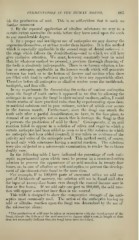Page 797 - My FlipBook
P. 797
FERMENTATION IN THE HUMAN MOUTH. 807
ish the production of acid. This is so self-evident that it needs no
further comment.
2. By the repeated application of alkaline substances we may to a
certain extent neutralize the acids before they have acted upon the teeth
to any considerable degree.
3. By a proper and intelligent use of antiseptics we may destroy the
organisms themselves, or at least render them inactive. It is this method
which is especially applicable in the second stage of dental caries— /. e.
the stage M-hich follows the decalcification—and to which we will here
give exclusive attention. We must, however, constantly bear in mind
that, by whatever metliod we proceed, a previous thorough cleansing of
tlie teeth is absolutely indispensable. There is no known solution, alka-
line or antiseptic, applicable in the human mouth which will penetrate
between the teeth or to the bottom of fissures and cavities when these
are filled with food in sufficient quantity to have any appreciable effect.
Therefore before all antiseptics or alkaline washes come the toothbrush,
toothpick, and floss silk.
In my experiments for determining the action of various antiseptics
upon the fungi of tooth caries it appeared to me that by allowing the
antiseptic to act upon, the fungi in their natural medium, saliva, I could
obtain results of more practical value tlian by experimenting upon them
in artificial solutions and in pure cultures, neither of which ever occurs
in the human mouth. Furthermore, since the fungi can attack the
teeth only after a partial decalcification, we have, in tlie first place, to
demand of an antiseptic not so much that it destroys the fungi as that
it prevents the production of acid by them.^ Consequently, if an acid
reaction failed to appear in a solution of saliva and sugar to which a
certain antiseptic had been added as soon as in a like solution to which
no antiseptic had been added (control), it was taken as evidence of the
activity and value of the antiseptic used. This method could, of course,
be used only with substances having a neutral reaction. The solutions
w^ere also subjected to a microscopic examination, to render the evidence
doubly sure.
In the following table I have indicated the percentage of each anti-
septic experimented upon which must be present in a sweetened-saliva
solution to prevent the appearance of an acid reaction in twenty-four
hours, or, in case of alkaline or acid antiseptics, to prevent the develop-
ment of the characteristic fungi in the same time.
For example, if to 100,000 parts of sweetened saliva we add one
part of bichloride of mercury, the solution will not be found acid after
the lapse of twenty-four hours even though the control become sour in
four or five hours. If we add only one part to 500,000, the acid reac-
tion will appear somewhat later than in the control.
This table is designed to show the comparative strength of the anti-
septics most commonly used. The action of the antiseptics having an
acid or alkaline reaction upon the fungi was determined by the use of
the microscope alone:
' The production of acid may be taken as synoTiymous with the development of the
fnngi, though the faihire of the acid reaction to appear after a certain length of time
does not necessarily indicate that the fungi have been devdalized.


